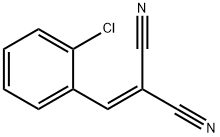CS, also known as o-chlorobenzylidene malononitrile, is a riot control agent (RCA) currently used by U.S. military forces. It was synthesized in 1928 and named 'CS' after its creators, Corson and Stoughton. CS replaced chloroacetophenone (CN) in 1959 as the primary RCA due to its higher safety ratio. It is more potent and safer than CN. CS can be disseminated pyrotechnically or in powder formulations like CS1 and CS2.
o-Chlorobenzylidene malonitrile is a combustible, white crystalline solid with a pepper-like odor. It is the defining component of tear gas (CS gas).
2-Chlorobenzylidenemalononitrile has found extensive application in exploring the effects of irritants on the human body. It is used as a tear gas and riot control agent.
ChEBI: 2-Chlorobenzylidenemalononitrile is an organochlorine compound.
White crystalline solid or light beige powder. Odor of pepper.
The finely powdered nitrile is a significant dust explosion hazard. Slightly soluble in water.
[(2-Chlorophenyl)methylene]malononitrile may react with strong oxidizers.
Toxic by inhalation and skin contact. Strong
irritant to eyes and mucous membranes.
o-Chlorobenzylidene malononitrile
(CS) aerosol is a potent lacrimator and
upper respiratory irritant.
Characteristic effects of CS exposure are
instantaneous conjunctivitis, blepharospasm,
burning, and pain.1 Prolonged exposure to high
concentrations in enclosed spaces may cause
pulmonary edema and severe bronchospasm.
Flash point data for [(2-Chlorophenyl)methylene]malononitrile are not available, but [(2-Chlorophenyl)methylene]malononitrile is probably combustible.
Poison by ingestion,
intraperitoneal, and intravenous routes.
Moderately toxic by inhalation. Human
systemic effects by inhalation: conjunctiva
irritation, cough, and unspecified respiratory
system effects. A human skin and eye
irritant. Human exposure data suggest
relatively low systemic toxicity, but intense
irritation of eyes, skin, and mucous
membranes. Mutation data reported. A tear
gas used for riot control. When heated to
decomposition it emits very toxic fumes of
Cl-, NOx, and CN-. See also NITRILES.
CS tear gas is used as a riot control
agent and is also used as an agent in CS1, CS2, and CSX
riot control, and tear gases.
If this chemical gets into the eyes, remove anycontact lenses at once and irrigate immediately for at least15 minutes, occasionally lifting upper and lower lids. Seekmedical attention immediately. If this chemical contacts theskin, remove contaminated clothing and wash immediatelywith soap and water. Seek medical attention immediately. Ifthis chemical has been inhaled, remove from exposure,begin rescue breathing (using universal precautions, including resuscitation mask) if breathing has stopped and CPR ifheart action has stopped. Transfer promptly to a medicalfacility. When this chemical has been swallowed, get medical attention. Give large quantities of water and inducevomiting. Do not make an unconscious person vomit.
o-Chlorobenzylidene malononitrile did
not cause a mutagenic response when tested in
a variety of assays that examined point mutations,
germinal gene mutations, chromosomal
breaks, and mitotic chromosome misdistribution.
5 Although limited, a study of the repeated
inhalation toxicity of CS in mice, rats, and
guinea pigs did not find a relationship between
tumors in a particular site and total dose of CS.6
F344N rats exposed at 0.075, 0.25, or 0.75mg/
m3 and B6C3F1 mice exposed at 0.75 or
1.5mg/m3 6 hours/day, 5 days/week for 2 years
had no compound-related incidences of neoplasm.
7 Nonneoplastic lesions occurred primarily in the nasal passages and included hyperplasia
and squamous metaplasia of the respiratory
epithelium.
Chemical/Physical. Hydrolyzes in water forming 2-chlorobenzaldehyde and malononitrile
(quoted, Verschueren, 1983).
Color Code—Blue: Health Hazard/Poison: Storein a secure poison location. Prior to working with thischemical you should be trained on its proper handling andstorage. Store in tightly closed containers in a refrigeratoror cool, well-ventilated area. Use only nonsparking toolsand equipment, especially when opening and closing containers of this chemical. Sources of ignition, such as smoking and open flames, are prohibited where this chemical isused, handled, or stored in a manner that could create apotential fire or explosion hazard.
UN2810 Toxic liquids, organic, n.o.s., Hazard
Class: 6.1; Labels: 6.1-Poisonous materials, Technical
Name Required. Military driver shall be given full and
complete information regarding shipment and conditions in case of emergency. AR 50-6 deals specifically with the
shipment of chemical agents. Shipments of agent will be
escorted in accordance with AR 740-32.
Tests conducted at Eglin Air Force Base near Ft. Walton Beach,
Florida, concluded that CS in soil has a ‘conservative’ half-life
of 3.9 days. Degradation of CS increases with soil and air
moisture, and with light exposure as it undergoes a slow
hydrolysis process. Olajos (2004) concluded that CS degrades
to o-chlorobenzaldehyde and malononitrile, the former of
which is ultimately converted to catechol under aerobic
conditions. Nitriles such as the malononitrile degradation
product of CS have a short half-life in soil and can be converted
readily to organic acids. Anaerobically, microalgae have
been reported to transform CS breakdown products into
benzoate. The U.S. Army Edgewood Research Development
and Engineering Center (USAERDEC) reports a solubility of
200 mg l-1.
CS concentrations attenuate in the atmosphere through three
processes: reaction with hydroxyl radicals, hydrolysis reactions
with atmospheric humidity, and deposition of particulate CS. It
should be noted that vapor pressure increases with temperature,
as should be expected. At 20°�C, CS vapor pressure is
3.5×10-5 mmHg, and at 60°�C, it is 5–7 mmHg.
Contact with strong oxidizers may cause
fire and explosion. May be explosive if dust mixes with air.



